In this article, I am discussing the PESTLE analysis of Starbucks as I examine the political, economic, social, technological, legal, and environmental factors that matter to Starbucks' business.
It is often seen as the most effective analytical tool for analyzing the impacts of external issues and it is an extended version of PEST analysis. Other forms of this tool are STEEP and STEEPLE.
Before moving into the Starbucks PESTLE analysis, let's briefly examine the industry the company operates within.
Coffee Industry and Starbucks Overview
The constant global economic recession has dented the macroeconomic environment which Starbucks operates in. The recession has hurt the consumer’s purchasing power.
Recent market research in 2024 reflects that consumers have not cut down on their coffee consumption. Instead, they are shifting to options with lower prices. This means that the firm can still influence the buying power by offering cheaper products.
Starbucks has taken steps to be a part of the mobile computing revolution. It has worked with Apple and introduced discounted coupons via iPhone apps. They also attempt co-branding and cross selling. Starbucks is well poised to enjoy the benefits of the Smartphone revolution.
Consumers in the US are also becoming more and more conscious of ethics. This means the brands they buy from should abide by social and environmental norms during production. Consumer awareness is challenging Starbucks.
These are the most obvious factors affecting the firm’s business. But there are many other factors seeking attention.
I have divided and organized these issues according to the PESTLE factors. You will find the details for how the factors impact business for Starbucks below.
Starbucks Political Factors
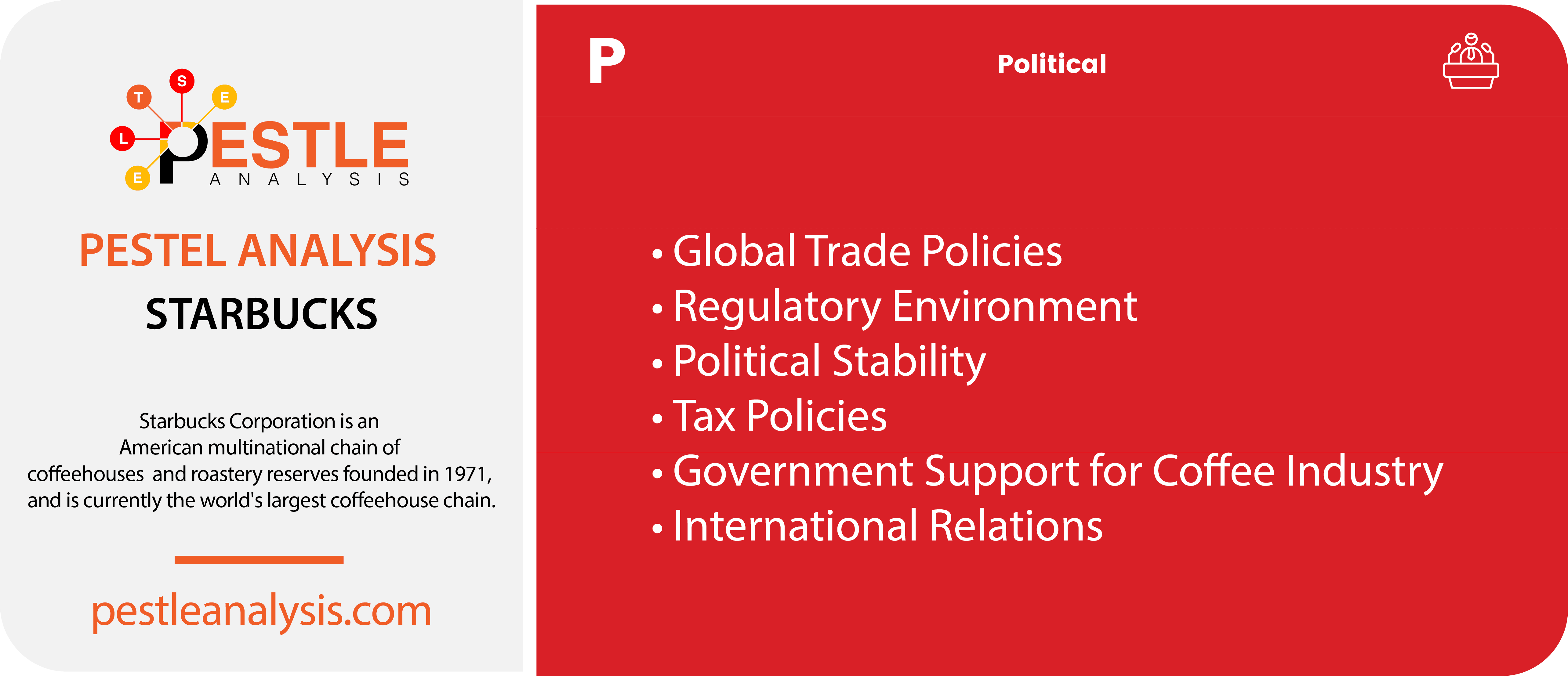
The main political factor is about sourcing the raw materials. This has gathered a lot of the attention from politicians in the West and from the source countries. For this reason, the company wants to adhere to social and environmental norms. It is willing to follow the sourcing strategies. It gives importance to fair trade practices.
Another impact is the need to follow the laws and regulations (compliance to the regulatory environment) in the countries from where Starbucks buys the raw materials. Activism and increased political awareness in developing countries have made it essential. The regulatory pressures within the US home market are also a factor. Multinationals based in the US are now subject to greater scrutiny of their business processes. The company must also monitor political stability within the country.
Some other factors to consider in the PESTEL analysis of Starbucks are:
Global Trade Policies
Starbucks operates in over 80 countries, making it highly susceptible to changes in global trade policies.
Tariffs and trade restrictions can affect Starbucks' supply chain, especially in the procurement of coffee beans, dairy products, and other raw materials. For example, increased tariffs on goods imported from certain countries can elevate costs or necessitate sourcing changes.
In March 2024, Starbucks announced a new global leadership structure to balance a clear geographical focus with investing in functional capabilities to scale around the world.
Tax Policies
Taxation varies significantly by region and can impact Starbucks' profitability. Changes in corporate tax rates, tax regulations on overseas earnings, and local sales taxes can influence business decisions, including pricing and location of new stores.
Government Support for Coffee Industry
In some regions, governments may provide subsidies or support for the coffee industry, which can benefit Starbucks by stabilizing coffee prices and ensuring a reliable supply. Conversely, the lack of such support or governmental favoritism towards local businesses could pose challenges.
Starbucks Economic Factors
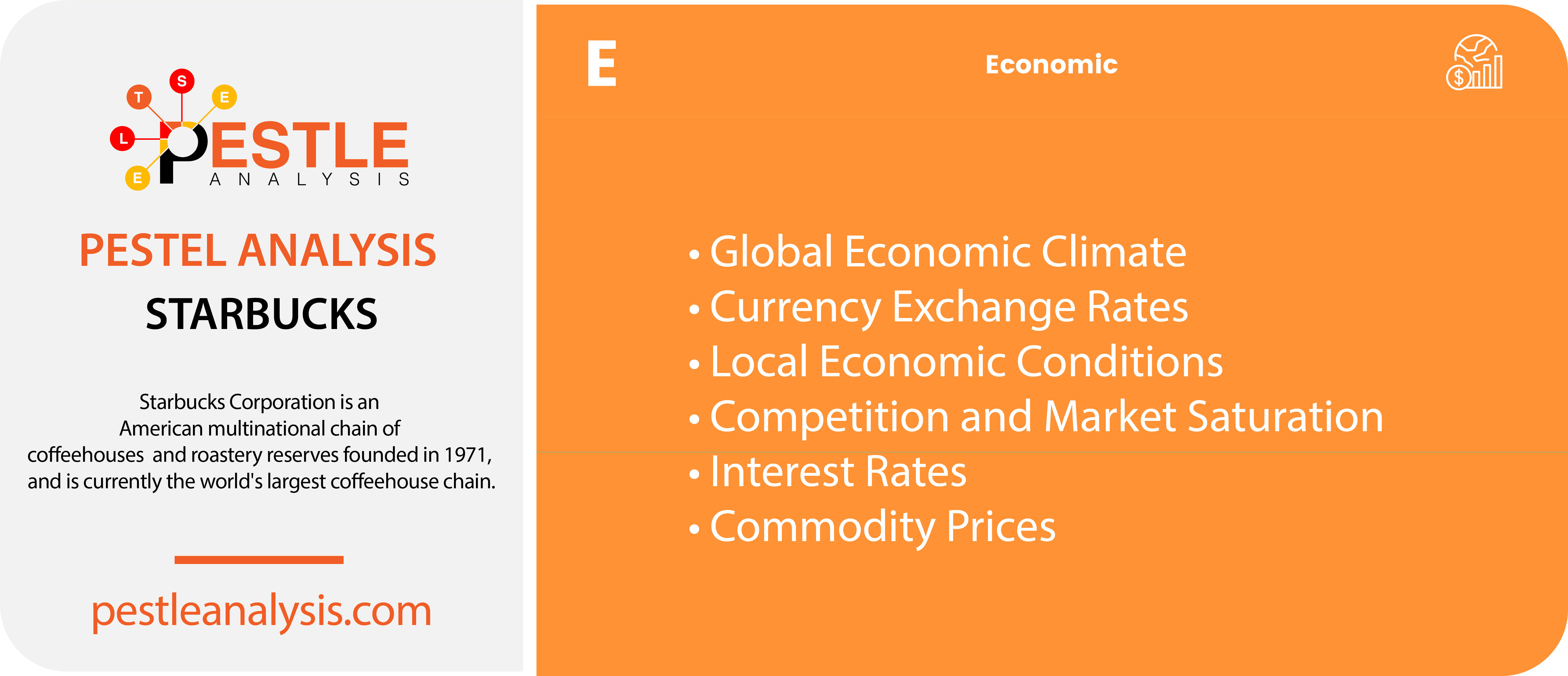
The ongoing global economic recession is the prime external economic driver for Starbucks. As I already mentioned, this factor dented the profitability of Starbucks. This has convinced buyers to shift to cheaper alternatives. As they did not quit buying coffee, Starbucks should seek an opportunity here.
The company has to deal with rising labor and operational costs. The inflationary environment and falling profitability is causing a lot of stress. Some other economic factors which can affect Starbucks are:
Local Economic Conditions
The economic conditions in specific markets where Starbucks operates can significantly impact its sales. High unemployment rates or low disposable income in a region can reduce store traffic and sales volumes, whereas more affluent areas may see higher sales figures.
Currency Exchange Rates
As a global company, Starbucks is exposed to currency fluctuations. These can affect the cost of importing raw materials and the profitability of overseas revenue when converted back to U.S. dollars. For instance, a strong dollar can make purchasing ingredients cheaper but can reduce the value of sales made in foreign currencies.
Competition and Market Saturation
Starbucks faces significant competition from both large chains and local coffee shops. Economic factors like market saturation can limit growth opportunities in certain regions, pushing Starbucks to innovate or explore less saturated markets for expansion.
Interest Rates
Interest rates affect borrowing costs for businesses and consumers alike. Lower interest rates can facilitate store expansion and renovations through cheaper access to capital. For consumers, lower rates mean more disposable income, potentially increasing spending on luxury items like specialty coffee.
Commodity Prices
The prices of commodities, especially coffee, dairy products, and sugar, have a direct impact on Starbucks' cost of goods sold. Volatility in these markets can affect profit margins if not managed properly through futures contracts and other financial instruments.
For example, coffee prices are breaking out to new highs in the first half of 2024, but analysts say the worst could be over for Starbucks.
Starbucks Social Factors
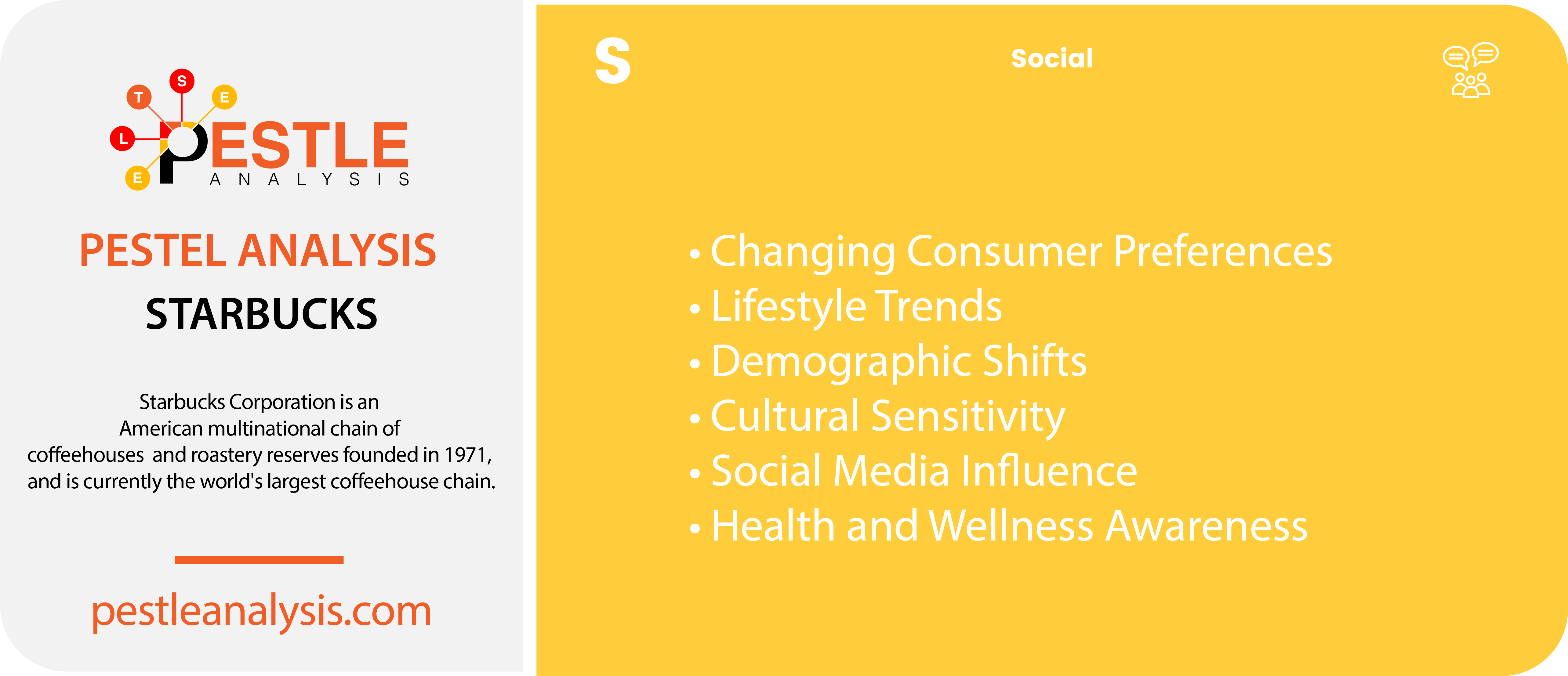
As already stated, Starbucks can offer cheaper products but it might have to sacrifice the quality. This is the main socio-cultural challenge that the coffee shop faces. It will expand consumer base to include the buyers from the lower and the middle-income tiers. Other socio-cultural factors to focus on are:
Demographic Shifts
The baby boomer generation is retiring. This means spending by older consumers will decrease. Now, Starbucks will have to tap the Gen X and the Millennials as customers. Starbucks' marketing and corporate responsibility initiatives often cater specifically to these groups, emphasizing sustainability and ethical sourcing.
Changing Consumer Preferences
Consumer preferences are continually evolving, with a growing demand for healthier, organic, and ethically sourced products. Starbucks has responded by expanding its range of options to include non-dairy alternatives, low-calorie options, and fair-trade coffee, catering to a broader audience and ethical consumerism trends.
Work and Lifestyle Trends
Coffee consumption has become more than just a morning ritual; it's a lifestyle choice for many. Starbucks capitalizes on this trend by offering a third-place experience—somewhere between home and work where people can relax or meet friends. Adapting to the increasing mobile and work-from-home trends, Starbucks has also enhanced its digital offerings and mobile ordering.
Health and Wellness Awareness
The “green” and “ethical chic” consumers are also concerning. They fret about social and environmental costs of the brands. There is an increasing awareness and concern among consumers regarding health and wellness. This has led Starbucks to introduce more health-conscious offerings, including sugar-free syrups, smaller portion sizes, and nutritional information transparency, aligning with consumer demands for healthier options.
Social Media Influence
Social media plays a significant role in shaping brand image and consumer behavior. Starbucks leverages this by creating Instagram-friendly store designs and photogenic products, like the seasonal Pumpkin Spice Latte, which often become viral sensations and draw customers.
Cultural Sensitivity
As a global brand, Starbucks must navigate and respect the cultural nuances of the markets it operates in. This includes adjusting product offerings to meet local tastes and preferences. For example, offering tea-focused beverages in China or adapting the spice level in food offerings in India.
Starbucks Technological Factors
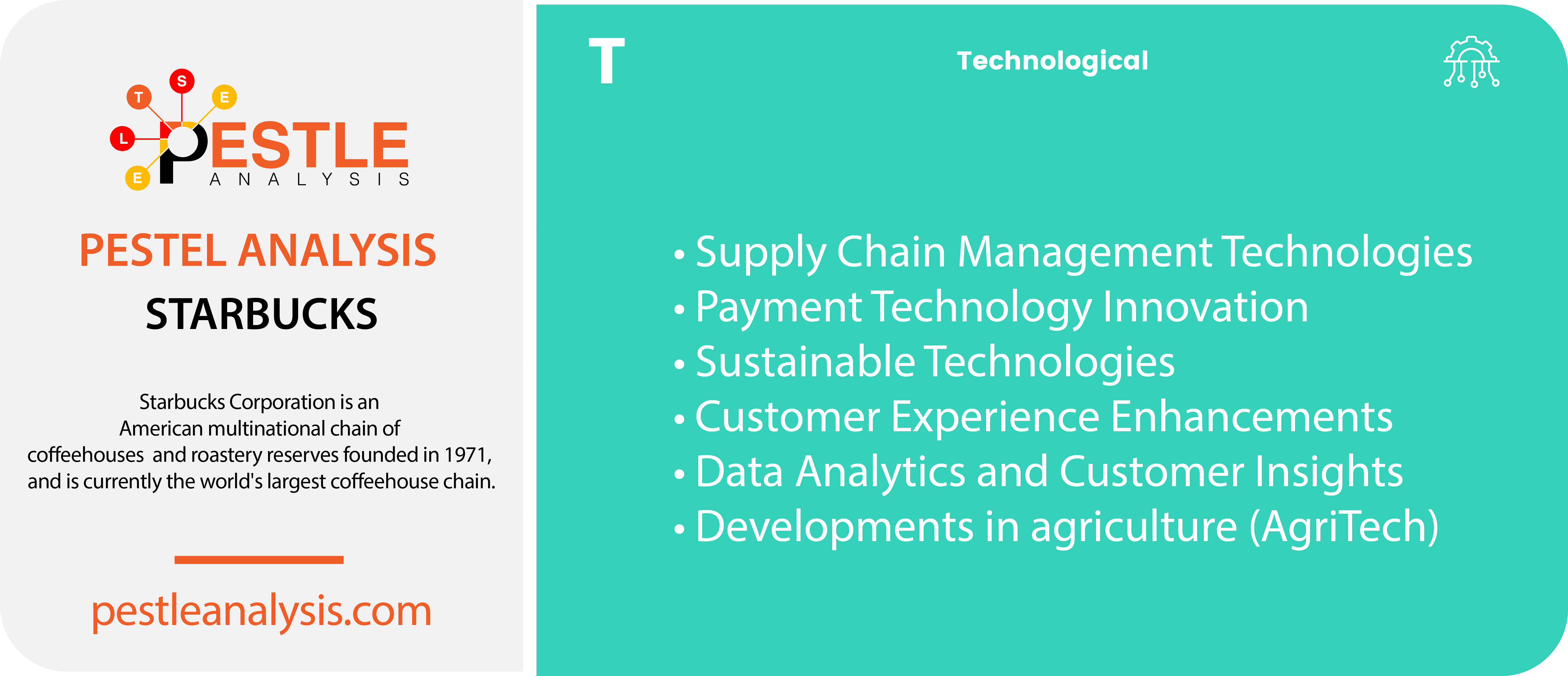
Supply Chain Management Technologies
Advanced technologies in supply chain management are crucial for Starbucks, enabling efficient inventory, logistics, and distribution systems. Implementation of technologies such as AI for demand forecasting and blockchain for traceability ensures that Starbucks can maintain its reputation for quality and sustainability while managing costs effectively.
Yet, Starbucks are ending its ‘Odyssey’ NFT program in March 2024 following a growing trend of non-crypto companies sunsetting NFT programs.
Payment Technology Innovations
The adoption of diverse payment technologies, including contactless payments and cryptocurrency, can cater to the changing preferences of customers. Starbucks is in a good position to enjoy the benefits of the emerging mobile wave.
Its partnership with Apple in 2014 to offer app-based discount coupons is helping it ride the mobile wave easily. Starbucks' exploration of these technologies could streamline transactions and enhance the customer experience, keeping the brand modern and accessible.
Sustainable Technologies
Starbucks has committed to significant sustainability goals, including reducing carbon emissions, water use, and waste. Technologies that contribute to these goals—like energy-efficient appliances, waste recycling systems, and water conservation methods—are integral to Starbucks' operations and brand image.
Customer Experience Enhancements
Technological enhancements in stores, such as WiFi connectivity, digital menu boards, and interactive tables, can improve the customer experience.
The company has introduced Wi-Fi capabilities in its outlets already. The Internet is important to consumers. They can now surf the web and do work while sipping Starbucks coffee. This is an added value to the brand. It enhances the overall consumer experience. Leveraging augmented reality (AR) to create immersive customer experiences or for promotional activities can also differentiate Starbucks from competitors.
Data Analytics and Customer Insights
Big data analytics play a vital role in understanding customer preferences, improving service delivery, and developing new products. Starbucks' ability to gather and analyze data from its app and loyalty programs helps tailor marketing strategies and customize offerings, enhancing customer satisfaction and retention.
Developments in agriculture (AgriTech)
AgriTech tools such as drones, satellite imaging, and IoT sensors help monitor coffee plantations, analyze soil conditions, and optimize water usage and fertilization. These technologies lead to better crop health, enhanced yields, and higher-quality coffee. Starbucks benefits from such advancements by ensuring a consistent and reliable supply of top-tier coffee beans.
Starbucks Environmental Factors
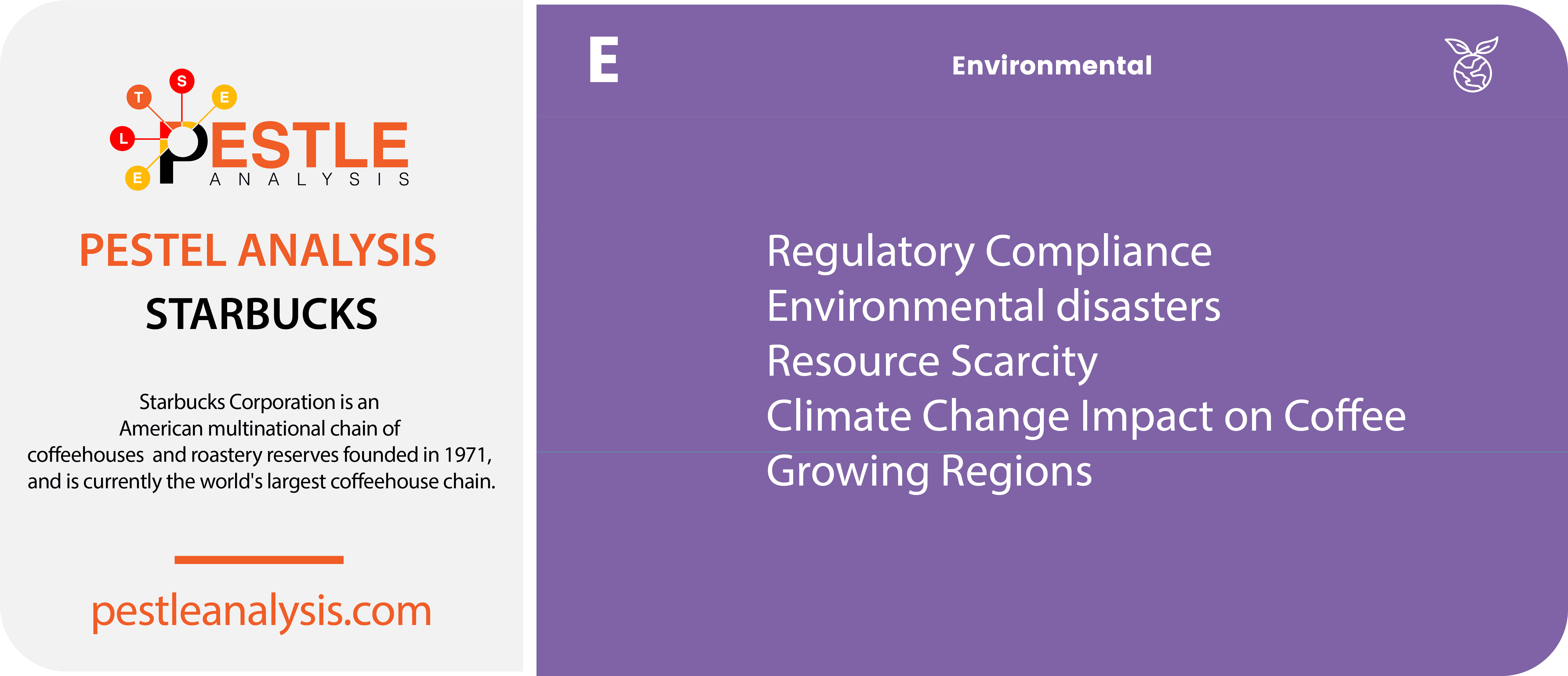
Many Starbucks business practices concern activists and international advocacy groups. Even the consumers have expressed issues. So, the company should take these into account to continue holding consumers’ trust. Some environmental factors Starbucks should worry about and are included in the Starbucks PESTEL analysis are:
Regulatory Compliance - Adherence to Environmental Laws
Starbucks must comply with a variety of environmental regulations across different regions, ranging from waste disposal and recycling laws to regulations governing emissions and energy use. Non-compliance can result in fines, legal challenges, and brand reputation damage.
Coffee Production and Supply Chain Vulnerabilities
Environmental disasters in coffee-producing countries pose significant risks to Starbucks, affecting everything from supply chain stability to pricing and profitability. These events, including hurricanes, droughts, floods, and volcanic eruptions, can devastate coffee crops, disrupt transportation and logistics, and have long-term impacts on the agricultural infrastructure that Starbucks relies upon.
Climate Change Impact on Coffee Growing Regions
Climate change poses a severe threat to coffee cultivation due to altered rainfall patterns, increased temperatures, and the proliferation of pests and diseases. These changes can affect the availability and quality of coffee beans, directly impacting Starbucks' supply chain.
Resource Scarcity - Water and Raw Material Availability
The coffee industry is heavily dependent on water, not just for growing coffee but also in the processing stages. Water scarcity in key coffee-growing regions can jeopardize crop yields and quality. Similarly, other resources like dairy and cocoa are also at risk due to environmental changes, influencing their cost and availability for Starbucks.
Starbucks Legal Factors
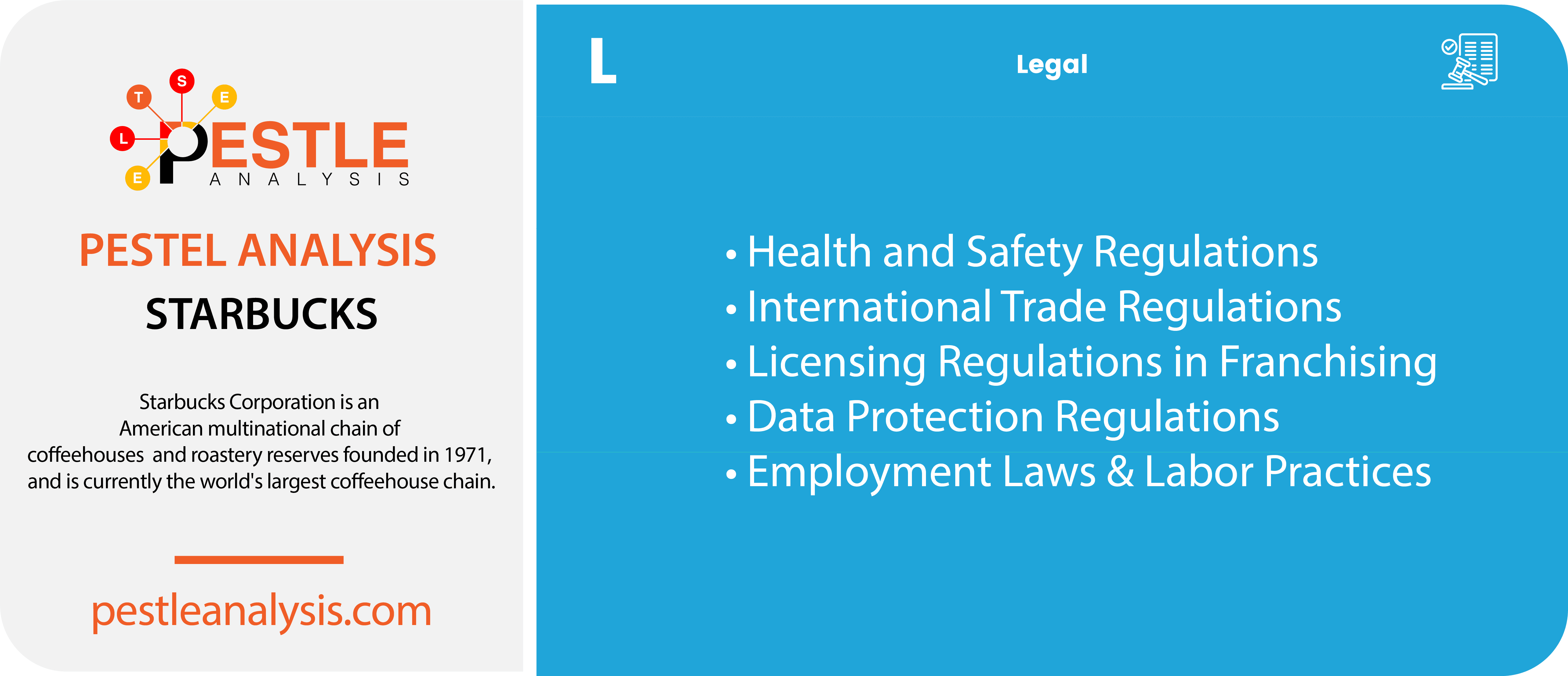
Starbucks must ensure that it does not violate any laws and regulations in the home market and countries from where it buys raw materials. It should also stay alert about the introduction of caffeine production and consumption-related policies and regulations by health authorities. Legal factors affecting Starbucks are:
Compliance with Health and Safety Regulations
Starbucks must adhere to strict health and safety regulations concerning food handling, preparation, and storage. Compliance is monitored by various health departments and agencies, with regulations often varying by country or region. Failure to comply can result in fines, legal actions, and damage to Starbucks' reputation.
International Trade Regulations - Import and Export Controls
Starbucks deals with the importation of coffee beans and other products from various countries, making it subject to trade regulations, tariffs, and customs laws. These can affect the cost and availability of goods and require careful legal scrutiny to optimize supply chain management.
Licensing Regulations in Franchising
Franchising is a pivotal growth strategy for many global brands, including Starbucks, which uses both company-operated and franchised store models to expand its global footprint. Understanding the licensing regulations in franchising is crucial for Starbucks to ensure legal compliance and maintain brand consistency.
Data Protection Regulations - Customer Information Security
With a robust digital presence and a popular loyalty program, Starbucks collects significant amounts of customer data. Compliance with global data protection regulations like GDPR in Europe and CCPA in California is critical to protect customer privacy and prevent legal issues.
Employment Laws & Labor Practices
As a global employer, Starbucks is subject to diverse labor laws including wage requirements, working conditions, and anti-discrimination laws. Ensuring compliance across different regions involves understanding and integrating a myriad of local labor laws into company policies and practices.
Recommendations based on the PESTLE Analysis of Starbucks
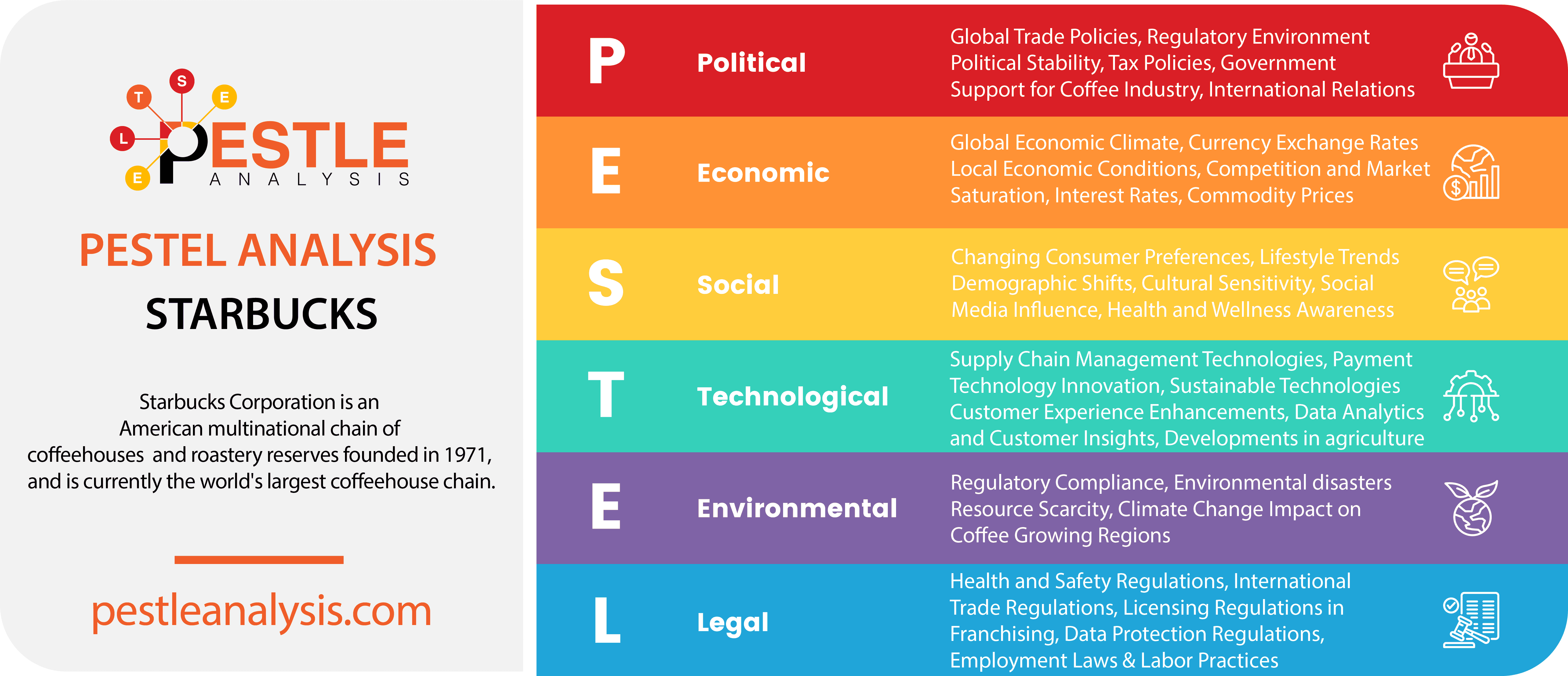
The Starbucks PESTLE analysis proves that Starbucks has a quite stable external environment. The key reason behind this might be that it operates in the Food and Beverage industry.
- Stay Informed: Regular updates on global trade policies will help Starbucks anticipate and mitigate risks associated with tariffs and trade wars.
- Adapt to Regulations: Continuous adaptation to the regulatory environments of the countries Starbucks operates in is essential for compliance and maintaining a good corporate image.
- Market Specific Strategies: Tailor business strategies to align with the economic conditions of each market, optimizing product offerings and pricing strategies accordingly.
- Innovative Responses: Address competitive pressures and market saturation by innovating new products and services that meet evolving consumer preferences.
- Commodity Price Hedging: Engage in commodity hedging practices to stabilize costs and protect profit margins against sudden increases in raw material costs.
- Focus on Demographics: Tailor marketing and product development to appeal to younger demographics, emphasizing ethical practices and sustainability to resonate with their values.
- Health Conscious Offerings: Continue expanding the range of healthy options to cater to the growing health and wellness trend among consumers.
- Invest in Mobile Technology: Continue to innovate and update the Starbucks app with new features that enhance convenience and personalize the customer experience.
- Improve Waste Reduction Efforts: Continue to innovate in packaging to reduce reliance on single-use plastics, increase the recyclability of materials, and encourage consumer behavior towards sustainability.
- Enhance Compliance Programs: Starbucks should continue to invest in robust compliance programs that ensure all health and safety, employment, and environmental regulations are met or exceeded.
- Invest in Data Security: As data privacy becomes increasingly important, investing in advanced security measures and privacy protocols is crucial to protect customer information and comply with international data protection laws.
For further reading, check out an analysis of one of Starbucks' main competitors or the PESTLE Analysis of the Coffee Industry:
- PESTLE Analysis of Subway
- PESTLE Analysis of Costa Coffee
- PESTLE Analysis of Dunkin
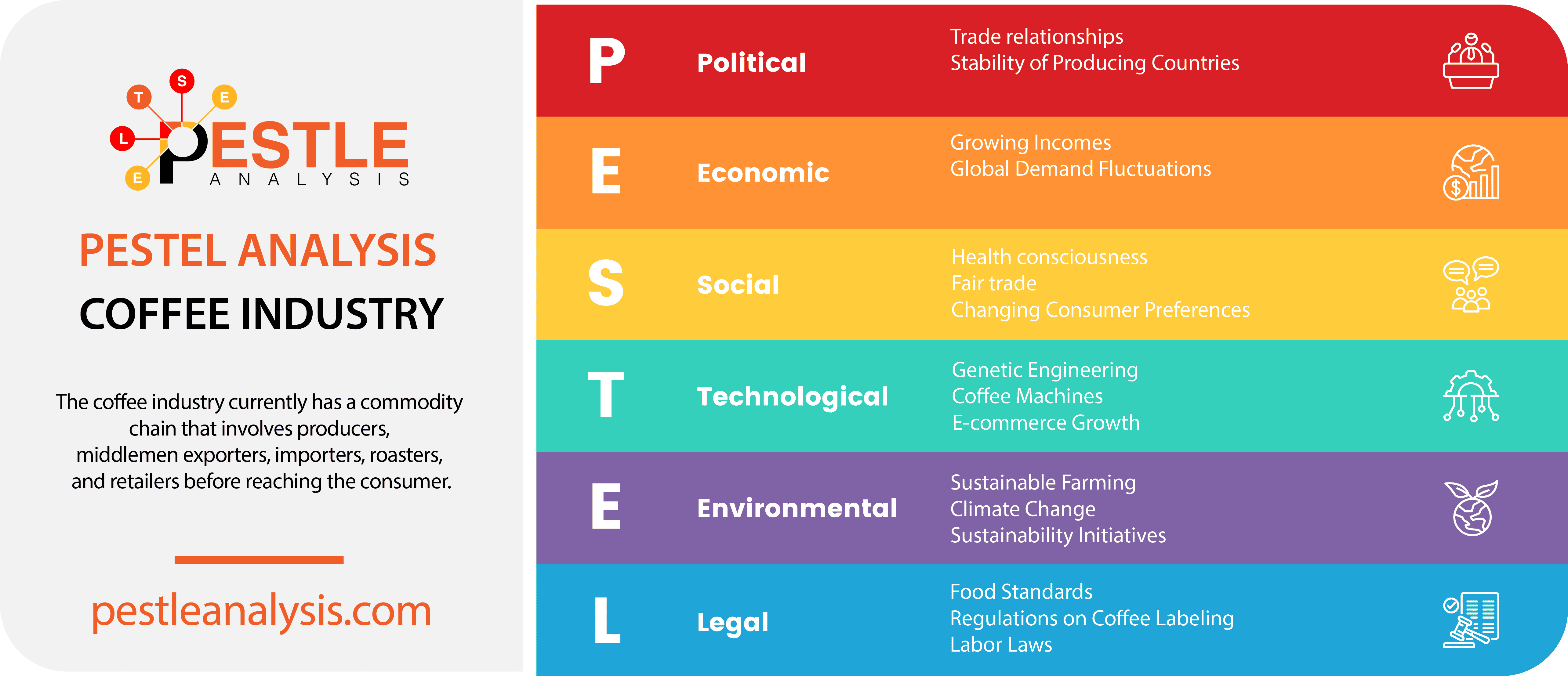
I hope you found this analysis of the PESTLE factors influencing Starbucks insightful and engaging! If you're keen to dive deeper and fully master the concept of PESTLE analysis, I highly recommend checking out our complete guide. It's packed with detailed explanations and enriched with practical examples to help you understand every aspect thoroughly.
Whether you're a student, a professional, or just curious about strategic business tools like me, our guide offers valuable insights that will enhance your understanding and application of PESTLE analysis. Happy reading, and I hope you enjoy exploring our comprehensive guide as much as you enjoyed this analysis!







